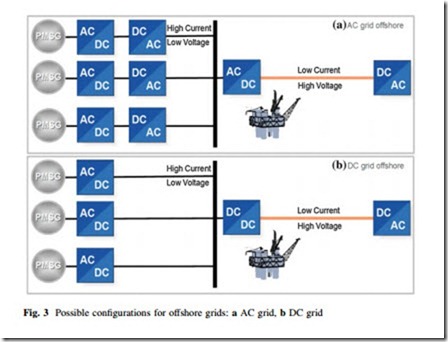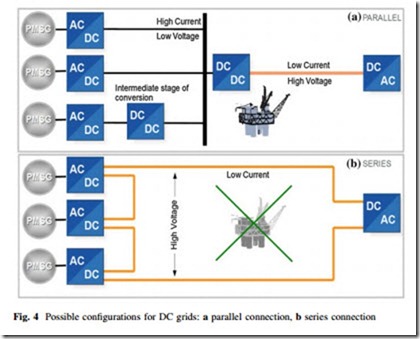Offshore Grid: AC Versus DC Topologies
HVDC transmission is the most cost-effective solution for offshore wind energy when there are large distances to the mainland. This transmission could be done in a conventional way in which the HVDC link interconnects two separated grids. However, new and fascinating alternatives are possible for offshore wind energy [15]. Many of these are based on the DC grid concept which arises naturally in the case of the wind energy since it requires AC/AC converters.
Any wind turbine must be equipped with a power electronic converter in order to control its rotational speed and hence, extract maximum power from the wind. An AC/AC converter is the most used alternative. However, many of the AC/AC converters have an intermediate DC conversion stage. It means what is called an AC/AC converter is in reality an AC–DC–AC converter as shown in Fig. 3a. It is possible to eliminate the last stage of conversion by using a DC grid as shown in Fig. 3b. This concept is called DC grid topology.
A DC grid could be a more efficient solution since it increases the utilization of cables offshore. In AC systems under ideal sinusoidal waveforms, cables must carry both active and reactive power. Needless to say reactive power increases the current and consequently transmission losses. However, total losses are given not only because of the transmission losses but also because of the efficiency of the converters themselves. In a DC grid, transformers are replaced with DC/DC converters. Different topologies have been proposed to increase the efficiency of these converters as will be studied in Sect. 4.
Permanent magnet synchronous generator (PMSG) is the most promising technology for OWFs with DC grids. A PMSG requires a full converter for its integration to the grid. A gearbox is not required with this technology if the machine is properly designed using high number of poles. Therefore, efficiency, reliability, and power density are increased by the use of PMSG.
Every DC/DC converter in a DC grid configuration must increase the voltage level in order to permit long distance power transmission. This allows different DC
grid configurations. A simple DC grid with parallel connection is shown in Fig. 4a. In this configuration, the DC/DC converter must increase the DC voltage from the generation level, usually less than 1 kV, to transmission level. A DC grid could have one or several stages of DC/DC conversion emulating the way it is done in conventional AC grids. This option is also shown in Fig. 4a.
In Fig. 4b, the high voltage required by the efficient is achieved by connecting turbines in series [16]. In this type of configuration, both the offshore grid and the transmission have the same low current. Therefore, efficiency is highly increased. In addition, the centralized DC/DC converter is not required allowing the elimination of the supporting platform. This affects the investment cost. Reliability is not compromised since the transmission distance is the same and hence, the probability of fault is similar to conventional HVDC transmission.

